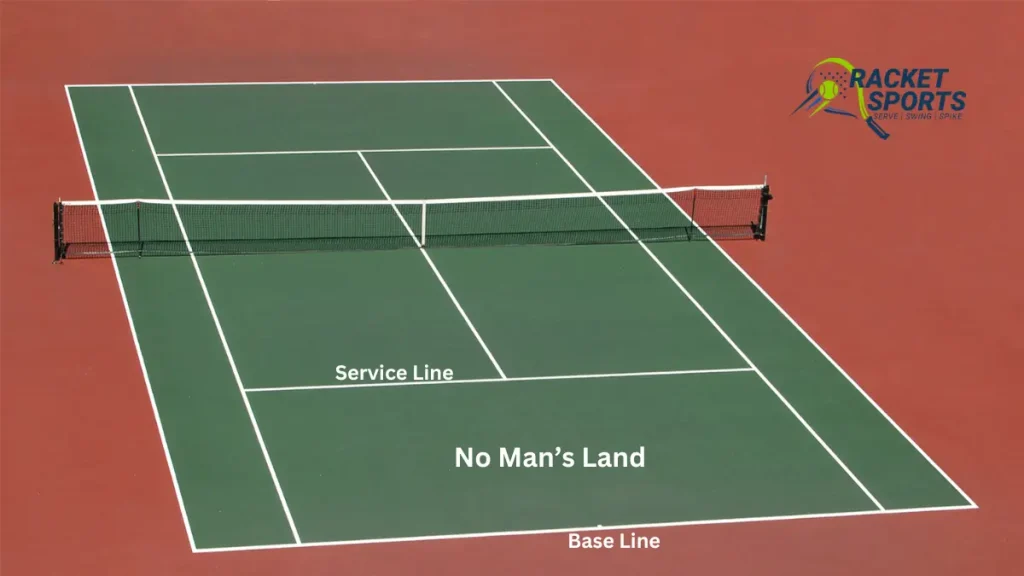3 Pro Tips for Avoiding No Man’s Land in Tennis 2025
In tennis, positioning is everything. Whether you’re attacking or defending, being in the right place on the court can determine the outcome of a point. But there’s one area that players are often warned to avoid — No Man’s Land.

This dreaded zone sits between the baseline and the service line, a place where players are vulnerable to both deep groundstrokes and sharp volleys. Understanding how to navigate this space can elevate your game and prevent easy losses.
Let’s dive deep into what No Man’s Land in tennis is, why it’s a dangerous position, and how to turn it to your advantage.
What is No Man’s Land in Tennis?
No Man’s Land, also known as the Dead Zone, is the area between the baseline and the service line. This position is considered dangerous because it forces players into an awkward middle ground, where they are neither in a strong defensive nor offensive stance. A player caught here is vulnerable to shots at their feet and struggles to hit deep, controlled returns.
Why is No Man’s Land a Weak Position?
Being stuck in No Man’s Land exposes you to several risks that can compromise your game.
- Limited Reaction Time – Since you are positioned too close to the baseline for proper groundstrokes but too far from the net for effective volleys, it becomes harder to react to fast-paced shots. Your opponent can use this to their advantage by hitting balls at your feet, making clean returns difficult.
- Awkward Shot Selection – Players in No Man’s Land often struggle to decide between a volley and a groundstroke. This hesitation can lead to mistimed shots or weak returns, allowing the opponent to take control of the rally.
- Vulnerability to Passing Shots – Since you’re in an intermediate zone, your opponent can easily target passing shots, forcing you to make difficult lunging returns. Skilled players will take advantage of this positioning to hit winners down the line or crosscourt.
By recognizing these weaknesses, players can work on strategies to either avoid this zone or use it strategically for brief transitions.
Pro Tips for Avoiding No Man’s Land
1. Move Efficiently
To stay out of trouble, you must be intentional with your movement. If you’re engaging in baseline rallies, avoid stepping forward unless you are preparing for an approach shot. If you plan to advance to the net, do so decisively rather than hesitating in No Man’s Land. Efficient movement ensures you maintain control and avoid getting stuck in awkward positions.
2. Master the Transition Game
A strong transition game is key to escaping No Man’s Land quickly. One way to do this is by developing powerful approach shots, which allow you to move forward with confidence. Additionally, practicing half volleys can help you handle shots that push you into this zone, making it easier to recover and reposition yourself effectively.
3. Improve Footwork & Positioning
Good footwork is essential to managing No Man’s Land effectively. Work on split-steps to enhance reaction time and adjust quickly to different shots. Training your movement between baseline rallies and net play will also help you avoid lingering in the Dead Zone. Agility drills and ladder exercises can further enhance your speed and balance on the court.
Related Tennis Terms
1. Approach Shot
An approach shot is a deep, aggressive shot played with the intent of moving closer to the net. It helps players transition out of No Man’s Land quickly and set up for an attacking volley. Mastering approach shots is crucial for players who want to dominate at the net and avoid getting caught in defensive positions.
2. Split-Step
A split-step is a small hop that helps players prepare for their opponent’s next shot. This movement is crucial in avoiding No Man’s Land because it enables quick adjustments, allowing players to either retreat to the baseline or move forward for a volley efficiently.
3. Passing Shot
A passing shot is a groundstroke aimed at getting past an opponent positioned near the net. This is a common tactic used against players who are stuck in No Man’s Land, as it forces them to react quickly and often results in defensive or unforced errors.
Essential Tennis Gear to Improve Your Game
If you want to avoid No Man’s Land and dominate the court, consider these must-have tennis items:
- Tennis Shoes: A good pair of court-specific shoes can improve traction and footwork, helping you move in and out of No Man’s Land efficiently. Popular choices include ASICS Gel Resolution and Nike Air Zoom.

- Tennis Racquets: A racquet with the right balance of power and control is essential. Models like the Wilson Pro Staff and Babolat Pure Aero help players execute powerful approach shots and volleys.
- Grip & Overgrips: Proper grip ensures better control of the racquet, especially when transitioning from the baseline to the net.
- Training Equipment: Agility ladders, resistance bands, and footwork drills can enhance movement, reducing the chances of getting stuck in No Man’s Land.
FAQs
Can I ever play from No Man’s Land?
Yes, but only briefly. Use it as a transition zone when moving between the baseline and the net.
How can I practice avoiding No Man’s Land?
Drills like approach shot drills, volley-to-baseline movement drills, and split-step timing exercises can help.
What if my opponent forces me into No Man’s Land?
Use a deep slice or a lob to reset the point and regain proper positioning.
What is the best shot to escape No Man’s Land?
A deep approach shot or a well-placed volley can help you transition out of the Dead Zone effectively.
How do professional players handle No Man’s Land?
Pros use advanced footwork, quick transitions, and well-placed shots to minimize their time in this dangerous area.
Conclusion
No Man’s Land in tennis is a tricky area that can cost you points if you linger there too long. Understanding its dangers, mastering footwork, and improving your transition game will help you stay in control.
Next time you hit the court, focus on intentional movement and strategic positioning to avoid getting caught in the Dead Zone!






